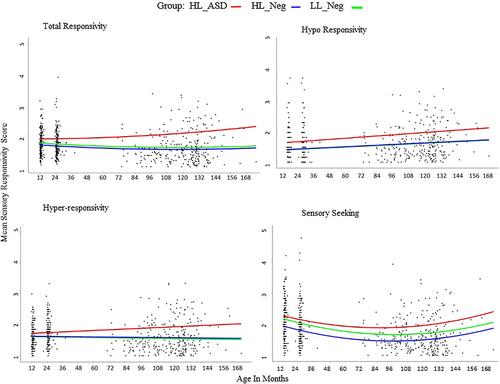Longitudinal analysis of sensory responsivity from infancy to school age in children at high and low familial likelihood for autism
Abstract
Background
Empirical evidence regarding the development of sensory responsivity in young children at high likelihood to develop autism spectrum disorder (ASD) remains relatively limited. It is unclear how sensory responsivity behaviors may change over time and impact later developmental outcomes. The goals of this study were to (a) characterize developmental trajectories of sensory responsivity across infancy (∼12 months), toddlerhood (∼24 months), and school age (6–11 years) in children at high and low familial likelihood for ASD; and (b) determine if sensory responsivity in infancy predicts adaptive and cognitive functioning at school age among children with ASD.
Methods
Generalized linear mixed effects models were used to examine scores from the Sensory Experiences Questionnaire in three groups of children including high-likelihood children later diagnosed with ASD (HL-ASD; n = 30), high-likelihood children without ASD (HL-Neg; n = 150), and low-likelihood control children not meeting ASD diagnostic criteria (LL-Neg; n = 94). Hierarchical linear regression was then used to examine the association between sensory responsivity scores in infancy and functional adaptive and cognitive outcomes at school age for children at high likelihood of ASD.
Results
Development of sensory responsivity from infancy to later childhood is best estimated by the effects of chronological age and Group for Sensory Seeking and Hypo responsivity and the additional effect of the interaction of Group and chronological age for Total and Hyper responsivity. Early elevated Hypo responsivity and Sensory Seeking scores are negatively associated with later adaptive behavior but not cognitive level.
Conclusion
Overall, higher degrees of Sensory Seeking and Hypo sensory responsivity are detectable in autistic children's behavioral repertoires by 12 months of age and associate with reduced adaptive functioning in middle childhood. These results point to the potential importance of early detection and treatment implications of early sensory behaviors.



 求助内容:
求助内容: 应助结果提醒方式:
应助结果提醒方式:


